|
Bada (Big) Ganpati
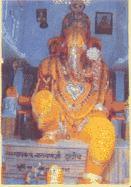 Better
known for its size than antiquity, this temple houses perhaps the
largest Ganesh idol in the world, measuring 25 ft. from crown to foot.
Created as a result of a dream to an Avantika (Ujjain) resident Shri Dadhich, it
was built in 1875. Better
known for its size than antiquity, this temple houses perhaps the
largest Ganesh idol in the world, measuring 25 ft. from crown to foot.
Created as a result of a dream to an Avantika (Ujjain) resident Shri Dadhich, it
was built in 1875.
The idol has a most interesting configuration of ingredients: bricks, lime
stone, masala made of gud, methi dana, soil collected from seven moksha puris:
Ayodhya, Mathura, Maya, Kashi, Kanchi, Avantika, and Dwaraka, mud from stables
of horse, elephant and cow, the powder of Pancharatna : heera, panna, moti,
manek and pukhraj (diamond, emerald, pearl, ruby and topaz) and the holy water
from all major places of pilgrimage. The metallic frame is of gold, silver,
copper, brass and iron. Twice a year in the 'Bhadwa' and 'Magh' months 'chola'
of pure ghee and 'Sindoor' is applied to Ganesh idol.
Idol
is believed to be miraculous.
(source: http://www.infodore.com/Badeganpati.html).
Top
of Page
The Afghan
Connection
Afghanistan is under
intense turmoil today. Yet it enjoyed close ties with mainland India for
millennia.
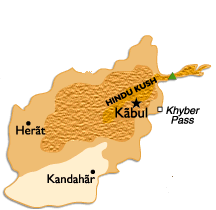 Afghanistan
was part and parcel of the socio-religious-political ethos of India. Close
cultural ties of Afghanistan and India go back to 4500 B.C. It enjoyed the
cultural and trade relations with the Indus-Saraswati culture that flourished in
the Indus valley. The deities of the Vedic culture like Apam Napat, Ahirbudhnya,
Maruts and the lost recension, the Bashkala samhita of the Rg Veda can be linked
to Afghanistan. The Arya-Dasa conflicts in the Rig Veda occured in the Seistan
province of southern Afghanistan. The purs destroyed by Indra were the mounds or
butts formed in the region due to the erosive action of Bad-i-sad-o-bist, ie.
wind of 120 days. Afghanistan
was part and parcel of the socio-religious-political ethos of India. Close
cultural ties of Afghanistan and India go back to 4500 B.C. It enjoyed the
cultural and trade relations with the Indus-Saraswati culture that flourished in
the Indus valley. The deities of the Vedic culture like Apam Napat, Ahirbudhnya,
Maruts and the lost recension, the Bashkala samhita of the Rg Veda can be linked
to Afghanistan. The Arya-Dasa conflicts in the Rig Veda occured in the Seistan
province of southern Afghanistan. The purs destroyed by Indra were the mounds or
butts formed in the region due to the erosive action of Bad-i-sad-o-bist, ie.
wind of 120 days.
Many tribes of
Afghanistan today are traced back to the Vedic period. They participated in the
famous Ten kings war of
the Rig Veda lore. The name of the nation itself is rooted in the ancient Indian
literature. The celebrated text of Brhatsamhita
by Varahamihira (6th century A.D.) refers to a group of people named avagana
along with Huns and Chinese (brhatsamhita 11.61) which in later period turned
into Avagana and then to Afghan. The Afghan identity is closely associated with
the Sanskrit origin. The Pakhtoons are the most dominating tribal group in
Afghanistan. The oldest text of the world, the Rig Veda refers to the tribal
enemies of the king Sudasa who had formed a federation against the king. The
tribal federation against the king Sudasa included Pakhtha, Bhalanasa, Alinasa,
Visani and Siva tribes.
Panini, the
great grammarian was a Pathan by birth. His contribution to the
Sankrta grammar is beyond comparison. Being a resident of the North-western
Frontier Province, his unique grammar astadhyayi contains several references to
the locations, tribes and geographical landmarks in the region. The roots of
abhiras tribes can be traced to Afghanistan. They were defeated by Nakula as
mentioned in the Mahabharata. (MHB Sabha
32.9-10). They participated in the Mahabharata War.
Language similarity between the
Kafiri language in Northern Afghanistan and Sanskrit
|
Kafiri |
Sanskrit |
| totta (father) |
tata |
| istri (female) |
stri |
| angura (finger) |
anguli |
| basana (cloth) |
vasana |
| asta (is) |
asti |
In the ancient
period Afghanistan was closely linked with Indo-Aryan and Indo-Iranian
civilization. Geographically Afghanistan lies at the center of two great
civilizations, namely, the Indian and the Iranian. Both have influenced the
cultural ethos of the region. Legend has it that the kingdom of Gandhaar was
established by Taksha, grandson of Bharat of Ayodhya. Gandhaar's borders
extended from Takshashila to Tashkent (corruption of 'Taksha Khand') in the
present day Uzbekistan. In the later period, Mahabharat relates Gaandhaari as a
princess of Gandhaar and her brother, Shakuni as a prince and later as
Gandhaar's ruler.
The north
Afghanistan lay on the famous ancient 'Silk Route.' The commercial activity and
spread of Buddhism gave impetus to the closer interactions with the Indian
civilization.
The word "Sthan"
is actually a Sanskrit derivative that means place or land.
There are a string of countries to the west of India with the suffix of "sthan,"
including Afghanisthan, Baluchisthan, Kurdisthan, Siwisthan, Arvasthan and
Turgasthan (Turkey). Until the 10th century A.D. Hindu kings ruled over
Afghanistan, and thereafter still in parts of it. As mentioned in Albiruni's
India, Hindu kings
continued to have their coronation in Kabul, although Kabul had passed out of
their hands. India's interest in the West and Central Asian region isn't
new either, with historic and cultural ties dating back centuries. At its peak
during the 1800s, the sweep of the greater Indian empire extended from Kabul to
Burma. Parts of Afghanistan were ruled by Indian kings and later the British,
and even after Afghanistan
became a separate nation, it continued to regard India as "the mother
country," according
to Monu Nalapat,
professor of geopolitics at the Manipal Academy of Higher Education in south
India. The famous “Kabuliwala” story by Rabindranath Tagore is a symbol of
India’s emotional and cultural ties with Afghanistan.
(source:
The
Afghan Connection - By P. V. Pathak and
Proof
of Vedic Culture's Global Existence - By Stephen Knapp
World Relief Network October 2000
ISBN 0961741066 and Subcontinental
Quicksand for the U.S. - Manjeet Kripalani
BusinessWeek Online October
23 2001).
For more information refer to Hindu
Kush and Bamiyan
Statues). For more
refer to chapter on Islamic
Onslaught and Glimpses
VII). For
more refer to chapter on Greater
India: Suvarnabhumi and Sacred
Angkor
Top
of Page
Entirely by
Memory
Rig
Veda is the oldest surviving religious record of the human race. Much
before the printing press came into existence,
Rig Veda was transmitted from one generation to another by word of mouth. Naturally,
question would arise about interpolations and mutilations during this
transmission. There
is a true story, almost unbelievable,
to answer this question of interpolations and mutilations in respect of Rig Veda.
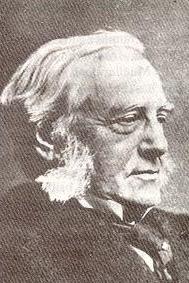 In
his book India:
What
can it teach us?
Friedrich Maximilian Müeller,
(1823-1900) German philologist and Orientalist. He repeatedly drew attention to
the uniqueness of the Vedas and awakened interest in Indology among educated
people. He writes: In
his book India:
What
can it teach us?
Friedrich Maximilian Müeller,
(1823-1900) German philologist and Orientalist. He repeatedly drew attention to
the uniqueness of the Vedas and awakened interest in Indology among educated
people. He writes:
"Entirely
by Memory:
This may sound startling,
but-what will sound still more startling,
and yet is a fact that can easily be ascertained by anybody who doubts it-at the
present moment, if every MS of the Rig Veda were lost,
we should be able to recover the whole of it - from memory of the Srotriyas in
India. These native students learn the Veda by heart, and then they
learn it from the mouth of their Guru, never from
a MS, still less from
my printed edition, - and after a
time they teach
it again to their pupils." I have had such students in my room at
Oxford, who not only could repeat these hymns, but who repeated them with
the proper accents (for the Vedic Sanskrit has accents like
Greek),
nay who, when looking through my printed edition of the Rig Veda, could point
out a misprint without the slightest hesitation.
“Of
course, this
learning by heart is carried on under a strict discipline;
it is, in fact, considered as a sacred duty. A
native friend of mine, himself
a very distinguished Vedic scholar, tells me that a boy, who
is to be brought
up as a student of the Rig-Veda,
has to spend about eight years in the house of his teacher. He
has to learn ten books: first,
the hymns of the Rig-Veda;
then a prose treatise on sacrifices, called
the Brahmana;
then the so-called Forest-book or Aranyaka;
then the rules of domestic ceremonies;
and lastly, six treatises on
pronunciation, grammar, etymology, metre, astronomy, and ceremonial.
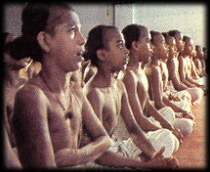 “These
ten books, it has been calculated,
contain nearly 30,000 lines,
each
line reckoned as thirty-two syllables. “A pupil studies every day,
during the eight years of his theological apprenticeship,
except on the holidays, which are
called "non-reading days". There
being 360 days in a lunar year, the
eight years would give him 2,880 days. Deduct
from this 384 holidays, and you get 2,496 working days
during the eight years. If
you divide the number of lines, 30,000,
by the number of working days, you
get about twelve lines to be learnt each day,
though much time is taken up, for
practicing and rehearsing what has been learnt before. “These
ten books, it has been calculated,
contain nearly 30,000 lines,
each
line reckoned as thirty-two syllables. “A pupil studies every day,
during the eight years of his theological apprenticeship,
except on the holidays, which are
called "non-reading days". There
being 360 days in a lunar year, the
eight years would give him 2,880 days. Deduct
from this 384 holidays, and you get 2,496 working days
during the eight years. If
you divide the number of lines, 30,000,
by the number of working days, you
get about twelve lines to be learnt each day,
though much time is taken up, for
practicing and rehearsing what has been learnt before.
"Now this is the state of things at present, though I doubt whether it would last
much longer
and I
always impress
on my
friends in
India, and
therefore impress
on those
who will
soon be
settled as
Civil Servants in India, the
duty of trying to learn all that can still be learnt from these living
libraries. Much ancient Sanskrit lore will be lost for ever when that of
Srotriyas becomes extinct."
(source: Selection from Hindu Scriptures - Prof. G. C.
Asnani - India). For more refer to chapter on Hindu
Scriptures and Quotes1_20).
Watch
An
Invasion through Conversion
- videoyahoo.com
Top
of Page
Myths of the
British Raj
There
have been persistent attempts of Western scholars to argue that "India was
not a country but a congeries of smaller states, and the Indians were not a
nation but a conglomeration of peoples of diverse creeds and sects. Anybody
familiar with the relevant situation will know that this attitude still forms
the major undercurrent of Western scholarship on India. (refer to article: Hindu
Nationalism Clouds the Face of India
- H. D. S. Greenway. Even today the
same attitude is alive and well, Mr. Greenway says in his article:
"Secularists realize that a united India was a product of the British
Empire. Before the British, Indians owed their allegiances to family, clan,
religion, or princely state. It was the British who established a centralized
administration, a common educational system, and countrywide transportation that
gave the subcontinent a sense of belonging to one country).
Regarding
countrywide transportation:
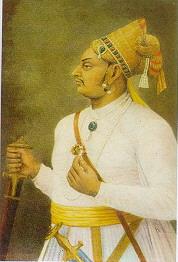 Amitav
Ghosh author
of several books, The Circle of Reason (1986), won France's top literary award,
Prix Medici Estranger, and The
Glass Palace also
makes fun of the claim that the British gave India the railways. Amitav
Ghosh author
of several books, The Circle of Reason (1986), won France's top literary award,
Prix Medici Estranger, and The
Glass Palace also
makes fun of the claim that the British gave India the railways.
"Thailand has
railways and the British never colonized the country," he says.
"In 1885, when the British invaded Burma, the Burmese king was already
building railways and telegraphs. These are things Indians could have done
themselves."
(source: Travelling
through time - interview with Amitav Ghosh). Please refer to chapter on
History of Hinduism
Note: The
Konkan Railway, the first major railway project in India since Independence, has
been a major success despite the difficult terrain and the logistics nightmares.
As for the story about the Konkan Railway, it is an inspiration. In the face of
obstacles, including extremely difficult terrain (many tunnels, bridges, etc) as
well as the task of raising large amounts of money through a public bond issue,
the railway was constructed on schedule and within budget.
It used to be said that Indians could never match the feats of the British
engineers who built much of India's network; isn't it amazing that E.
Sreedharan, the man who ran this Herculean effort,
is a virtual unknown?
(source: Historicide:
Censoring the past... and the present. Refer to Indian
engineering skills go poetic and heroic in the Western Ghats
Education:
"
Every village had its schoolmaster, supported out of the public funds; in Bengal
alone, before the coming of the British, there were some 80,000 native schools -
one to every four hundred population. Instruction was given to him in the
"Five Shastras" or sciences: grammar, arts and crafts, medicine, logic
and philosophy. Finally the child was sent out into the world with the wise
admonition that education came only one-fourth from the teacher, one-fourth from
private study, one-fourth from one's fellows, and one-fourth from life."
(source:
Story
of Civilization: Our Oriental Heritage - By Will Durant
MJF Books.1935 p.556-557).
Christian
missionaries and the British are also proud that they brought
education to India, "but," counters Sri Sri Ravi
Shankar, Founder of the
Bangalore based Art of Living, an International Foundation. He recently
addressed the UN Peace Summit on Aug 28. He is the only non-westerner to serve
on the advisory board of Yale University's School of Divinity and is author of
the book - Hinduism and Christianity:
"it is not true: there were for instance 125,000 medical
institutions in Madras before the British came. Indians never lacked
education, the Christians only brought British education to India,
which in fact caused more damage to India by westernizing many of
us."
Sir
John Woodroffe,
(1865-1936) the well known scholar, Advocate-General of Bengal and sometime
Legal Member of the Government of India. Referring
to the Macaulay's Educational Minute of 1834
(for education refer to chapter on Hindu
Culture and First
Indologists)
he wrote:
"To
an Indian, self-conscious of the greatness of his country's civilization, it
must be gall and wormwood to hear others speaking of the "education"
and "civilization" of India. India who has taught some of the deepest
truths which our race has known is to be 'educated.' She whose ancient
civilization ranks with the greatest the world has known is to be
civilized."
(source: Is
India Civilized - Essays on Indian Culture - By Sir John Woodroffe
Ganesh & Co. Publishers 1922 p.290).
European
travelers and administrators bear testimony to the great veneration in which
Hindus held learning and instruction. One of the earliest observation
was made on the subject of indigenous education was by Fra
Paolino Da Bartolomeo. Born in Austria, he spent 14 years in India
(1776-1789). He wrote: "No people, perhaps, on earth have adhered as much
to their ancient usage and customs as the Indians." and "temperance
and education contribute, in an uncommon degree, to the bodily confirmation, and
to the increase of these people."
Brigadier-General
Alexander Walker who served in India between 1780-1810, says, that "no
people probably appreciate more justly the importance of instruction that the
Hindus."
The fact of
wide-spread
education - a school in every village - was uniformly noticed by most early
observers. Even writing as late as 1820, Abbe
J. A. Dubois says that "there are very few villages in which one
or many public schools are not to be found...that the students learn in them all
that is necessary to their ranks and wants...namely, reading, writing and
accounts."
(source: On
Hinduism Reviews and Reflections - By Ram Swarup p. 179-180 -
refer to chapter on Hindu
Culture and Education in Ancient
India and European
Imperialism).
 In
October 1931 Mahatma Gandhi made a statement
at Chatham House, London, that created a furore in the English press. He said,
"Today India is more illiterate than it was fifty or a hundred years ago,
and so is Burma, because the British administrators, when they came to India,
instead of taking hold of things as they were, began to root them out. They
scratched the soil and left the root exposed and the beautiful tree
perished". Mahatma Gandhi said,
"The beautiful tree of education was cut down by you British. Therefore
today India is far more illiterate than it was 100 years ago." We
now learn, with almost a sense of disbelief, that a large part of the country
did have a sustainable education system, as late as even the early years of the
19th century, and that this was systematically demolished over the next 50 years
or so. The present education system is, in effect, a legacy of the colonial
rule. This system has perpetuated the notion that traditional societies were
seeped in ignorance, superstition and rituals for thousands of years and lived a
life of abject poverty, which was caused by an extreme form of social
discrimination and exploitative socio-political systems. So deep has this notion
seeped into our collective consciousness that, it colours the belief of both,
providers of education as well as of recipients and aspiring recipients in our
society. In
October 1931 Mahatma Gandhi made a statement
at Chatham House, London, that created a furore in the English press. He said,
"Today India is more illiterate than it was fifty or a hundred years ago,
and so is Burma, because the British administrators, when they came to India,
instead of taking hold of things as they were, began to root them out. They
scratched the soil and left the root exposed and the beautiful tree
perished". Mahatma Gandhi said,
"The beautiful tree of education was cut down by you British. Therefore
today India is far more illiterate than it was 100 years ago." We
now learn, with almost a sense of disbelief, that a large part of the country
did have a sustainable education system, as late as even the early years of the
19th century, and that this was systematically demolished over the next 50 years
or so. The present education system is, in effect, a legacy of the colonial
rule. This system has perpetuated the notion that traditional societies were
seeped in ignorance, superstition and rituals for thousands of years and lived a
life of abject poverty, which was caused by an extreme form of social
discrimination and exploitative socio-political systems. So deep has this notion
seeped into our collective consciousness that, it colours the belief of both,
providers of education as well as of recipients and aspiring recipients in our
society.
(source: http://www.indiatogether.org/education/opinions/btree.htm).
(For more please refer to noted
Gandhian, Dharampal's book. The
Beautiful Tree, (Biblia Impex, Delhi, 1983).
***
Sense of
belonging: Hinduism
has imparted to the whole of India a strong and stable cultural unity that has
through the ages stood the shocks of political revolutions.
James Ramsey MacDonald
(1866-1937) first Labor Party prime minister of Great Britain has said: "India
and Hinduism are organically related as body and soul."
(source: The
Soul of India - By Satyavrata R Patel p.208).
Political Unity
of India since Ancient Times
The name
Bharatvarsha has a deep historical significance, symbolizing, a fundamental
unity. The term was associated not only with the geographical
boundaries but also with the idea of universal monarchy. The term was associated
not only with the geographical boundaries but also with the idea of universal
monarchy. This name together with the sense of unity imparted by it "was
ever present before the mind of the theologians, political philosophers and
poets who spoke of the thousand Yojanas (Leagues) of land that stretches from
the Himalayas to the sea as the proper domain of a single universal
emperor".
This is what is stated in an
inscription of King Yasodharman of Mandasor, Successors
of the Guptas in the North:
"From the lands where the
Brahmaputra flows,
from the flanks of the southern hills, thick with grove of palms,
from the snowy mountains whose peak the Ganga clasps,
and from the ocean of the West,
come vassals, bowing at his feet,
their pride brought low by his mighty arm,
and his palace court is a glitter,
with the bright jewels of their turban."
The rulers of medieval India also
considered India as one geographical unit and sought to extend their sway over
the whole of the land. The song Vandematram embodies
that sense of unity.
There is also an
under-current of religious unity among the various religious sects in the
country. That is partly due to the overwhelming impact of Hinduism on the Indian
mind which transcends any other single religion. This is mainly due to the
comprehensive and all-embracing pervasiveness of Hinduism. Hinduism is not a
mere form of religious approach or system. It is a "mosaic of almost all
types and stages of religious aspiration and endeavor."
(source: Ancient
India - By V. D. Mahajan p. 15).
The unifying effect of Hinduism and
Sanskritic culture was great. Records dating from the early centuries indicate
that shrines regarded sacred by all Hindus were located at widely separated
points in all directions. Clearly, some concept of religious and cultural unity
already existed. Long pilgrimages to such shrines created for many a connection
with peoples in areas under different sovereignties. Then, too, the great body
of Sanskritic literature provided a significant bond.
(source: India:
A World in Transition - By Beatrice Pitney Lamb
p. 32).
According to Jawaharlal
Nehru: "Right from
the beginning, culturally India has been one, because she had the same
background, the same traditions, the same religions, the same heroes and
heroines, the same old tales, the same learned language (Sanskrit), the village
panchayats, the same ideology, and polity. To the average Indian the whole of
India was a kind of punya-bhumi
- a holy land - while
the rest of the world was largely peopled by mlechchhas and barbarians.
Sankaracharya
chose the four corners of India for his maths,
or the headquarters of his order of sanyasins, shows how he regarded India as a
cultural unit. And the great success which met his campaign all over the country
in a very short time also shows how intellectual and cultural currents traveled
rapidly from one end of the country to another."
(source: Glimpses
of World History - By Jawaharlal Nehru
p. 129).
Dr. Radhakrishnan: "In spite of the divisions, there is an inner cohesion among the Hindu society
from the Himalayas to the Cape Comorin."
(source: The
Hindu View of Life - By Sir. Sarvepalli Radhakrishnan
p. 73-77).
Girilal Jain,
late editor of Times of India: " It is about time we recognize that we are
not a nation in the European sense of the term, that is, we are not a fragment
of a civilization claiming to be a nation on the basis of accidents of history
which is what every major European nation is. We are a people primarily
by virtue of the continuity and coherence of our civilization which has survived
all shocks. And though inevitably weakened as a result of foreign invasions,
conquests and rule for almost a whole millennium, it is once again ready to
resume its march."
(source:
Hindu
Phenomenon - By Girilal Jain
South Asia Books 1998 ISBN 8174760105 p. 21).
Guy Sorman
visiting scholar at Hoover Institution at Stanford and the leader of new
liberalism in France, says that the idea of a nation-state was an 18th century creation of the West.
It is the cultural identity that has helped India stay together. The
British did not do it for the love of India. It was here that the West started
to colonize what was to become the Third World, a shameless process of
systematic exploitation without any moral or religious justification.
(source: The
Genius of India - By Guy Sorman (Le Genie de l'Inde)
Macmillan India Ltd. 2001. ISBN 0333 93600 0 p. 197)
N. S.
Rajaram: "It was claimed by the British, and faithfully repeated by the
Leftist intellectuals, that the British unified India. This is
completely false. The unity of India, rooted in her
ancient culture, is of untold antiquity. It may have been divided at
various times into smaller kingdoms, but the goal was always to be united under
a ‘Chakravartin’ or a ‘Samrat’. This unity was cultural though not
always political. This cultural unity was seriously damaged during the Medieval
period, when India was engaged in a struggle for survival — like what is
happening in Kashmir today. Going back thousands of years, India had been united
under a single ruler many times. The earliest recorded emperor of India was
Bharata, the son of Shakuntala and Dushyanta, but there were several others. I
give below some examples from the Aitareya Brahmana.
"With this great
anointing of Indra, Dirghatamas Mamateya anointed Bharata Daushanti.
Therefore, Bharata Daushanti went round the earth completely, conquering on
every side and offered the horse in sacrifice.
"With this great anointing
of Indra, Tura Kavasheya anointed Janamejaya Parikshita. Therefore Janamejaya
Parikshita went round the earth completely, conquering on every side and
offered the horse in sacrifice."
There are similar statements
about Sudasa Paijavana anointed by Vasistha, Anga anointed by Udamaya Atreya,
Durmukha Pancala anointed by Brihadukta and Atyarati Janampati anointed by
Vasistha Satyahavya. Atyarati, though not born a king, became an emperor and
went on conquer even the Uttara Kuru or the modern Sinkiang and Turkestan that
lie north of Kashmir. There are others also mentioned in the Shathapatha
Brahmana and also the Mahabharata. This shows that the unity of India
is ancient. Also, the British did not rule over a unified India. They had
treaties with the rulers of hereditary kingdoms like Mysore, Kashmir, Hyderabad
and others that were more or less independent. The person who united all these
was Sardar Patel, not the British. But this unification was possible only
because India is culturally one. Pakistan, with no such identity or cultural
unity, is falling apart.
(source: Distortions in
Indian History http://www.voi.org/books/dist/ch2.htm#3
Sri Aurobindo
has said: "In India at a very early time: the
spiritual and cultural unity was made complete and became the very
stuff of the life of all this great surge of humanity between the Himalayas and
the two seas....Invasion and foreign rule, ....the enormous pressure of the
Occident have not been able to drive or crush the
ancient soul out of the body her Vedic Rishis made for her."
(source: India's Rebirth
- By Sri Aurobindo
Publisher: Mira Aditi ISBN 81-85137-27-7 p 158).
Sri Jayendra Saraswati - The
Sankaracharya of Kanchi
has said:
The British never created
anything in India - they merely destroyed. Instead of uniting, they divided; so
the question is meaningless. For five thousand years Hindus have chanted in
their morning prayers:
"Gange
cha Yamunechaiva! Godavari! Sarasvati!
Narmade! Sindhu! Kaveri! Jale asmin sannidhim kuru!"
"Hail!
O ye Ganges, Jamuna, Godavari, Sarasvati, Narmada,
Sindhi and Kaveri, come and approach these waters."
There has been an explicit and clear
geographical area that we have referred to as our land. Adi Sankara not only
went to the four corners of this territory, he set up tens of shrines all over
the Hindu land to be able to revive and revitalize Hinduism. It is absurd to
think that India is a new idea.
(source: Interview with Sri Jayendra Saraswati - by
Rajeev Srinivasan - India Abroad March 8'2002). For more refer to
chapters on European
Imperialism and Glimpses
VIII).
For
more refer to chapter on Greater
India: Suvarnabhumi and Sacred
Angkor
Top
of Page
Priceless
Indian treasures that are part of the Queen's collection
Priceless Indian treasures that are part of
the queen's collection that will not be returned to India can be seen at the
largest exhibition of crown treasures to be launched next year.
Among the riches on display will be the famous Shivaji's
sword and some of the possessions of Guru
Gobind Singh
and Bird
of Paradise from the throne of
Tipu Sultan. The
British took away this priceless figure in gold and emeralds after the death of
the legendary warrior king of Mysore. The palace is reportedly keen not to fuel
such demands by showing too much that India might want back.
(source: http://www.rediff.com/us/2001/nov/27uk.htm).
For refer to chapters on Glimpses
VIII and European
Imperialism).
Excellence of Vedic Culture
Huent Sung,
a Chinese visitor to ancient India has noted in his travel account:
"The Kshatriyas and Brahmans
are clean-handed, unostentatious, pure and simple in life and very frugal. They
are pure of themselves and not from compulsion. With respect to the ordinary
people although they are naturally light-minded yet they are upright and
honorable. In money-matters they are without craft, and administering justice.
They are considerate. They are not deceitful and treacherous in their conduct
and are faithful to their oath and promises. In their rule of government there
is remarkable rectitude. while in their behavior there is much gentleness."
(source: Ancient
India - By Dr. R. C. Majumdar p. 454).
For
more refer to chapter on Greater
India: Suvarnabhumi and Sacred
Angkor
Top
of Page
Saffron - A
sacred symbol vulgarized?
Many
of should decry the cynical misuse of the idea and spiritual associations of
saffron by the Indian media. Saffron
is a vibrant visual symbol for those who are nurtured in the Vedic tradition,
and it evokes powerful associations of self-renunciation, purity, sacrificial
dedication and moral dynamism.
It is in
this sense, and not in any narrow communal sense, that saffron finds its
rightful place on our national tricolour, as Jawaharlal
Nehru noted while moving the resolution for its adoption as our flag
in the Constituent Assembly. We
have remained passive witnesses to the continued communal vulgarization of this sacred
symbol. Alarmingly, the situation is already so confusing that many
people today associate saffron with nothing more than communalism!
I would urge the media to give no quarter to the abuse
of religious symbols like this. As Confucius said, calling things by
their right names is the bottom-line of public service. Using the word
‘saffronisation’ as a synonym for ‘communalisation’ is a frontal insult
to the spiritual sentiments of a large section of the people of this country and
deserves to be denounced.
(source: Swami
Agnivesh of
Bandhua Mukti Morcha http://www.hindustantimes.com/nonfram/100901/detlet01.asp).
Top
of Page
The Roman Empire -
A Gangster State?
According to Peter
Beckman, author of ' A History of Pi: " While Alexandria had become the world capital of
thinkers, Rome was becoming the capital of thugs. Rome was not the first state
of organized gangsterdom nor was it the last; but it was the only one that
managed to bamboozle posterity into an almost universal admiration. Few rational
men admire the Huns, the Nazis or the Soviets; but for centuries, schoolboys
have been expected to read Julius Caesar's militaristic drivel. They have been
led to believe that the Romans had attained an advanced level in the sciences,
the arts, law, architecture, engineering and everything else.
It is my opinion that the alleged
Roman achievements are largely a myth; and I feel it is time for this myth to be
debunked a little. What the Romans excelled in was bullying, bludgeoning,
butchering and blood bath. They enslaved peoples whose cultural level was far
above their own. They not only ruthlessly vandalized their countries, but they
also looted them, stealing their art treasures, abducting their scientists and
copying their technical know-how, which the Romans' barren society was rarely
able to improve on.
Then there is Roman engineering: The
Roman roads, acqueducts, the Coliseums. Warfare, alas, has always been
beneficial to engineering. In a healthy society, engineering design gets smarter
and smarter; in gangster states, it gets bigger and bigger.
The architecture of the Coliseums and other places of Roman entertainment are difficult to judge without recalling
what purpose they served. It was here that gladiators fought to the death; that
prisoners of war, convicts and Christians were devoured by a many as 5,000 wild
beasts at a time; and that victims were crucified or burned alive for the
entertainment of Roman civilization. When the Roman screamed for ever more
blood, artificial lakes were dug and naval battles as many as 19,000 gladiators
were staged until the water turned red with blood. The only Roman emperors who
did not throw Christians to the lions were the Christian emperors. They
(Christians) threw
the pagans to the lions with the same gusto and for the same crime - having a
different religion.
Romans were not primitive savages,
but were sophisticated killers. The Roman contribution to sciences was mostly
limited to butchering antiquity's greatest mathematicians, burning the Library
of Alexandria. and it demonstrates an abysmal ignorance of sciences. Pliny
tells us that in India there is a species of men without mouths who subsist by
smelling flowers.
Yet most historians extol the
achievements of Rome. "it accustomed the Western races to the idea of a
world-state, and by pax romana....."
(source: A History of Pi
- by Peter Beckan St. Martin's Press; ; 19th edition (August 1976)
0312381859 p. 55-59). For more
refer to chapter on India
and Greece).
Top
of Page
Martand Surya
Temple of Kashmir
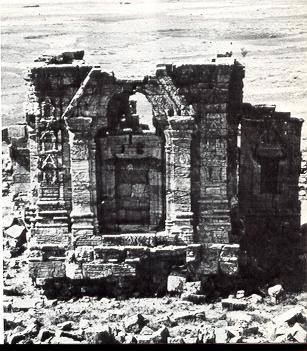 Perhaps
the best-known early structure in Kashmir is the ruin of the Surya temple at
Martand. Built within a large rectangular courtyard (220 by 140 feet), edged by
a massive stone wall, the Sun Temple is situated on a high plateau with a magnificent
view of distant snow-covered mountains. This majestic shrine was erected by the
great Kashmiri king Lalitaditya Maktapida,
who is recorded in the Kashmiri chronicle Rajatarangini
as conquering most of Northern India. The riches gathered from this campaign
embellished not only the Surya Temple but others in Kashmir, and later made them
in turn objects of plunder. Perhaps
the best-known early structure in Kashmir is the ruin of the Surya temple at
Martand. Built within a large rectangular courtyard (220 by 140 feet), edged by
a massive stone wall, the Sun Temple is situated on a high plateau with a magnificent
view of distant snow-covered mountains. This majestic shrine was erected by the
great Kashmiri king Lalitaditya Maktapida,
who is recorded in the Kashmiri chronicle Rajatarangini
as conquering most of Northern India. The riches gathered from this campaign
embellished not only the Surya Temple but others in Kashmir, and later made them
in turn objects of plunder.
(source: Indian
Art - By Roy C. Craven p. 177)
The most memorable and beautiful work of Lalitaditya
is the construction of spacious Martand temple which the emperor got built in
honour of the Sungod (Bhaskar). It may be mentioned here that Lalitaditya was
himself a Kshatriya of Surya dynasty. The style of the construction of the
temple and the skill of the makers are rare in the history of the world.
According to Stein, it is not possible to find and excavate cities, towns and
the ruins belonging to the era of Lalitaditya. But from whatever material and
ruins, found and excavated so far, one learns about the fame of their matter
Lalitaditya. The remnants of the big Martand temple, which the emperor had built
at the pilgrimage of the same name, is an example of unique building skill of
ancient Hindus. These ruins, even in total disarray, receive praises for their
design, beauty and art.
(source: Translation of
Rajtarangani - By Stein Page 60). For
more refer to chapter on Glimpses
VIII).
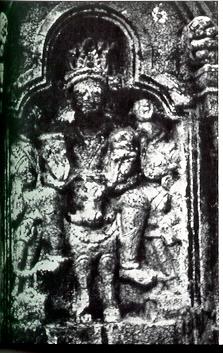 According
to Younghusband Martand has a very high
place in the world's great architecutral designs. According
to Younghusband Martand has a very high
place in the world's great architecutral designs.
It is an example of not only
the Kashmiri architectural skill but it has pride of having been set up at a
fine spot which is prettier than the spots where Parthinan, Taj Mahal, St.
Peters have been built. It can be considered either a representative of all such
great buildings and monuments or a combination and sum total af all the
qualities. It gives an insight into the greatness of the people of Kashmir. The
ruins of the huge temple stand in a square field with snow capped mountains of
the smiling valley as the background. In terms of beauty and strength and in
grandeur it is next to Egypt and Greece. This temple has been built with strong
and square limestones. The temple has received grandeur and beauty through the
pillars of Greek pattern. It is now in ruins and there are many such ruins
scattered in Kashmir. The very existence of this temple encourages man to carry
out study of the skill and art of Kashmiris. Anyone bereft of the love of nature
could not select such a special spot for the construction of the temple. A
restless and destructive mind would have not been able to built such a spacious
and praiseworthy temple.
(source: Kashmir - By
Younghusband Page 201).
(source: http://www.kashmir-information.com/ConvertedKashmir/Chapter5.html.
For more refer to chapter on Glimpses
VIII).
For
more refer to chapter on Greater
India: Suvarnabhumi and Sacred
Angkor
Top
of Page
Is Yoga the Work
of the devil?
 Fundamentalist Christians in Georgia
stopped the Toccoa-Stephens County Recreation Department from offering a Yoga
class. Philip Lawrence, who headed the fight against the class, solicited help
from a number of local church organizations. He claimed Yoga could lead to devil
worship. Christian conservatives and other rigid and dogmatic religious sects
have some serious issues with Yoga. The Yoga
Sutras offer a philosophy which includes the Yamas and Niyamas -
suggestions for living. These suggestions encourage honesty, purity, devotion,
chastity, non-violence and non-stealing. Many people who practice Yoga
eventually find themselves embracing many of these ideals. Of course, according
to Fundamentalist Christianity, good works will not get you into Heaven - only
accepting Jesus Christ as Lord will do that. Hindu belief that a spark of the
divine exists within every living being. Hindus also believe in an immortal
soul. Fundamentalist Christians disagree completely with these ideas - according
to their beliefs, seeing God in yourself creates a void which can be filled with
very dangerous forces. In addition, there are many conservative interpretations
of the Bible which assert that the soul is not immortal and can be destroyed. Fundamentalist Christians in Georgia
stopped the Toccoa-Stephens County Recreation Department from offering a Yoga
class. Philip Lawrence, who headed the fight against the class, solicited help
from a number of local church organizations. He claimed Yoga could lead to devil
worship. Christian conservatives and other rigid and dogmatic religious sects
have some serious issues with Yoga. The Yoga
Sutras offer a philosophy which includes the Yamas and Niyamas -
suggestions for living. These suggestions encourage honesty, purity, devotion,
chastity, non-violence and non-stealing. Many people who practice Yoga
eventually find themselves embracing many of these ideals. Of course, according
to Fundamentalist Christianity, good works will not get you into Heaven - only
accepting Jesus Christ as Lord will do that. Hindu belief that a spark of the
divine exists within every living being. Hindus also believe in an immortal
soul. Fundamentalist Christians disagree completely with these ideas - according
to their beliefs, seeing God in yourself creates a void which can be filled with
very dangerous forces. In addition, there are many conservative interpretations
of the Bible which assert that the soul is not immortal and can be destroyed.
As many as 20
million Americans practice yoga in pursuit of physical or mental fitness, with a
little om along the way. According to BBC
News, "Madonna
is a big fan. So is Sting. They are just two stars who are devoted practitioners
to the discipline of yoga. An increasing number of people have taken up the
ancient eastern health and fitness practice."
(source: Is
yoga good for you? - BBC News). Former
Spice Girl Geri Halliwell is doing it on TV flashing her newly flat stomach,
Madonna and Sting swear by it and ever more vigorous variations are crossing the
Atlantic with enticing images of toned and fit ‘yogis’, Uma Thurman and
Christy Turlington, but no one is sure just how American British yoga should be
allowed to get.
(source: Times
of India).
A few years ago the Pope issued a proclamation telling Catholics, particularly
monks and priests, to avoid yogic practices and mixing Catholicism with Eastern
traditions like the Hindu and Buddhist.
(source: Hinduism:
The Eternal Tradition (Sanatana Dharma) - By David Frawley Voice of
India. ISBN 81-85990-29-8 p. 233-234).
Kristin Davis gives youth yoga high marks.
"Yoga has been around 5,000 years. It doesn't matter if actresses are doing
it. People are responding to yoga on a deeper level. It's not a fad."
Actor-turned-Health Minister Shatrughan
Sinha was today all
praise for Yoga and said his practicing of the physical exercise for nearly two
decades has kept him fit.
(source: Outlookindia.com).
For more on yoga, please refer to chapter on Yoga
and Hindu Philosophy).
Top
of Page
Dhyana
(meditation) = Jhana = Ch'an = Zen
According to Dr.
Ananda Coomaraswamy, late curator of the Boston Museum: " Japanese Buddhism on the ritualistic side
elaborated the cult of Amida and the Western Paradise, and on the mystical side
the practice of the Ch'an Buddhists of China, which had been established, ca.
527-536, by the Indian monk Boddhidharma, and derived in the last analysis from
the Indian Yoga.
Dhyana (meditation) = Jhana = Ch'an
= Zen. The external influence of Indian thought created a theology and forms of
art resembling those of India; the more fundamentally stimulating influence of a
method, acting inwardly, enabled the Japanese genius to realize itself in an
attitude of aesthetic appreciation of natural beauty and an art which bear no
evident resemblance to anything Indian.
(source:
History
of Indian and Indonesian Art - By Ananda K. Coomaraswamy
Dover Pubns; ; Reprint edition (August 1985) ASIN 0486250059
p. 155).
The Japanese word
Zen(na) (Chinese Ch'an(na); Sanskrit Dhyana) refers
to the unity of mind which can be obtained through spiritual practice.
(For more refer to chapter on India
and China and Glimpses
X). For more refer to
chapter on Greater India:
Suvarnabhumi and Sacred
Angkor
Top
of Page
Oldest
and largest group of Jews in India
Bene Israel, the oldest and largest
group of Jews remaining in India. The Bene Israel claim to be descended from the
Ten Lost Tribes of Israel. Jews trace their roots back two millennia - were
always able to live freely as Jews in India. There are 4,500 in India today. Some
3,500 of them, including Ezekiel and Joseph, live in and around Bombay. There
are also a few hundred Baghdadi Jews in Bombay and Calcutta, 70 in Cochin (once
a flourishing Jewish center), and several hundred in Thane, a 400-year-old
Jewish community about 40 km. from Bombay.
That history has been untarnished
by antisemitism. " The Hindus have traditionally
been very tolerant of other religions," says Ezekiel, who works
at the Israeli consulate in Bombay and is very active in the Jewish community.
Joseph, a businesswoman, nods in agreement, but adds that she did experience
anti-semitism when she was growing up - at the hands of
Catholics. Like many members of the Jewish community of Bombay, she
attended a convent school because of its high standards and English-language
instruction.
"The Jews in the school were constantly
taunted," she recalls. "The nuns would say: 'You killed Christ.'"
Indeed,
in a recent report, UNESCO pointed out that out of 128
countries where Jews lived before Israel was created, only one, India, did not
persecute them and allowed them to prosper and practice Judaism in peace.
(source: To
the Very Last Jew - The Jerusalem Post and (source:
Redefining
India
- By Francois Gautier - dailypioneer.com December 11 '02). For
more refer to chapter on Glimpses
VI and Glimpses
VII).
Top
of Page
Hindu
Palace of Cairo, Egypt
"Walking
in the suburbs of the famous city, I was pleasantly surprised to find a Hindu
Palace in the elite suburb of Heliopolis. From the
outside, this mansion looks just like one of the fabulous Hindu temples of
Orissa with the Garuda and other Hindu icons sculpted on its facade. The
Palais Hindu was
completed in 1911. Since it is one of the protected monuments of the Egyptian
Archaeological Department, there was no problem in walking into the grounds of
the building and examining it at close quarters. This palace with beautiful
sculptures of Hindu deities was vacant. It
was known as the Hindu Palace for nearly 90 years.
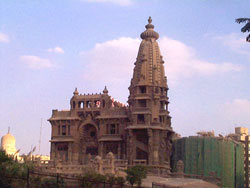 An
article was published in the Egyptian Gazette two decades ago, describing
the history of the palace. The
Belgian-born industrialist, Baron-General Edouard-Louis-Joseph
Empain (1852-1929), belonging to one of the eminent aristocratic
families of France, had extensive business interests in Indonesia. An eminent
Egyptologist, after his retirement from his commercial career, he decided to
settle down in Cairo. Ever since the interest shown by Napoleon 200 years ago,
France has always been in the forefront when it comes to study of Egyptology. During
the turn of the century, Empain
became the adviser to the Egyptian Government on metropolis planning. He
developed the suburbs of Cairo into magnificent plazas/gardens/and residential
areas. For his own home, he chose Heliopolis — the best portion of the
super-rich planned suburb. He decided to build a huge mansion, which was to be a
copy of the Indonesian Hindu temples he had seen during his sojourn in that
country. He obtained the best Indonesian artists and sculptors for its
construction. In a matter of few years, the Hindu Palace became one of the
magnificent buildings of Cairo." In the early 70s, Muslim fundamentalists,
especially in Saudi Arabia, were enraged that, at the citadel of Muslim Cairo,
there is a Hindu palace with the icons of Hinduism represented! An
article was published in the Egyptian Gazette two decades ago, describing
the history of the palace. The
Belgian-born industrialist, Baron-General Edouard-Louis-Joseph
Empain (1852-1929), belonging to one of the eminent aristocratic
families of France, had extensive business interests in Indonesia. An eminent
Egyptologist, after his retirement from his commercial career, he decided to
settle down in Cairo. Ever since the interest shown by Napoleon 200 years ago,
France has always been in the forefront when it comes to study of Egyptology. During
the turn of the century, Empain
became the adviser to the Egyptian Government on metropolis planning. He
developed the suburbs of Cairo into magnificent plazas/gardens/and residential
areas. For his own home, he chose Heliopolis — the best portion of the
super-rich planned suburb. He decided to build a huge mansion, which was to be a
copy of the Indonesian Hindu temples he had seen during his sojourn in that
country. He obtained the best Indonesian artists and sculptors for its
construction. In a matter of few years, the Hindu Palace became one of the
magnificent buildings of Cairo." In the early 70s, Muslim fundamentalists,
especially in Saudi Arabia, were enraged that, at the citadel of Muslim Cairo,
there is a Hindu palace with the icons of Hinduism represented!
(source: The
palace that is an enigma
- K.
R. N.
Swamy - tribuneIndia.com).
Top
of Page
Servants for the
Afterlife
In Ancient Egyptian burial it was
important that the deceased had a workforce to carry out their every day tasks
in the underworld so they would not have to dirty their hands. Originally in
high ranking Old Kingdom burials servants were buried with their masters. It is
not known if these were sacrifices, or people honored with a resting place
beside their King when they died. The Egyptians had as many as 2000 gods and
goddesses. Some, such as Amun, were worshipped throughout the whole country,
while others had only a local following.
Often gods and goddesses were represented as part human and part animal. For
example, Horus, the sky god, had the head of a hawk, and body of a human.
Top
of Page
Annam Brahma -
Food is God
The Upanishads state "Annam
Brahma" - "Food is God," and therefore it must be given the
highest veneration. Even today, in many Indian homes, be they meager or
affluent, a symbolic offering of food is given to Brahma before every
meal.
(For more refer to chapter on Glimpses
VIII).
Russia's
Fascination with Valmiki Ramayana Continues
Russia is
perhaps the only European country where the Valmiki Ramayana, the story of Lord
Rama written by the Hindu sage Valmiki, has sold tens of thousands of copies in
Russian. More than a thousand people offered prayers and tributes to
the Hindu God Ram in the first ever Ramnavami celebrations, at which Russian
artists and writers who took Ram's story to the people were felicitated. The
Jawaharlal Nehru Cultural Center (JNCC) at Moscow organized a function to honor
those who are associated with translating and staging the Ramayana as a play in
Russia.
While eminent Indologist Alexander Baranikov
first translated the Ramayana into Russian in 1948, Natalia Guseva, another
prominent scholar on India, had written the script for a play based on the
Indian epic that was staged in Moscow Children's Theatre in the Soviet Union for
the first time in 1957. The Ramayana, popularly perceived as a tale of triumph
of good over evil, is used extensively for inculcating noble values in Russian
children, and has been staged in scores of cities many times over during the
past five decades.
(source: http://www.indiaabroaddaily.com/2001/04/08/08ramayan.html).
For more refer to chapter on Greater
India: Suvarnabhumi and Sacred
Angkor
Top
of Page
Prosperity of
Ancient India
For well over a millennium and a
half, the Indian subcontinent may have been the richest area in the world. As
early as the first century A.D., a statesman in ancient Rome wrote in worried
vein about the squandering of Roman wealth on Indian luxuries. In south India,
large hoards of ancient Roman coins have been unearthed. The legend of the
wealth of the "Indies" continued to grip Western minds. A few intrepid
world travelers, Marco Polo among them, confirmed it with eyewitness accounts.
The power of this legend caused Columbus in 1492 to take his dangerous journey
westward across the Atlantic, seeking to re-establish direct contact with India.
As late as the eighteenth century, British observers were repeatedly struck by
the material prosperity of the land they were beginning to conquer.
(source: India:
A World in Transition - By Beatrice Pitney Lamb
p. 19). For more refer to chapter on
Hindu Culture1.htm
and
Hindu Culture2
and
European Imperialism).
Top
of Page
The Gobind Deva
Temple
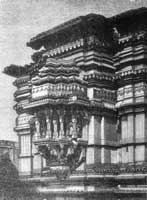 The
Gobind Deva temple in Vrindavan, Mathura, is indeed massive; its plinth is 105
to 117 feet. Its height today is about 55 feet. It is estimated that the
original height was twice this, without which the mashaal (torch) could not have
been possible to be seen either from Agra or from Delhi. The temple was built in
1590 by Maharaja Mansingh of Jaipur.
Bharatvarsha. For
the satisfaction of its desecraters, the celia, or the sanctum sanctorum, was
destroyed. Fortunately, the idol of Sri Krishna or Gobind had been removed to
Jaipur by the pujaris in anticipation of Aurangzeb's proposed visit in 1670; the
emperor was already notorious as an iconoclast. The
Gobind Deva temple in Vrindavan, Mathura, is indeed massive; its plinth is 105
to 117 feet. Its height today is about 55 feet. It is estimated that the
original height was twice this, without which the mashaal (torch) could not have
been possible to be seen either from Agra or from Delhi. The temple was built in
1590 by Maharaja Mansingh of Jaipur.
Bharatvarsha. For
the satisfaction of its desecraters, the celia, or the sanctum sanctorum, was
destroyed. Fortunately, the idol of Sri Krishna or Gobind had been removed to
Jaipur by the pujaris in anticipation of Aurangzeb's proposed visit in 1670; the
emperor was already notorious as an iconoclast.
The roof of the
truncated edifice was to be reserved for names. No sooner than the mehraab was
constructed, as illustrated in the photograph copied from History of Indian and
Eastern Architecture by James Fergusson,
(John Murray; London), Aurangzeb inaugurated it by himself offering prayers.
Prof R Nath, author of History
of Mughal Architecture (Delhi, Abhinav 1985), introduces the subject
of the Gobind Deva temple by quoting Aurangzeb's decree of April, 1669. It said,
"...eager to establish Islam, (Aurangzeb) issued
orders to the governors of all the provinces to demolish the schools and temples
of the infidels (Hindus) and with the utmost urgency put down the teaching and
the public practice of the religion of these disbelievers."
The great temple of Gobind Deva fell a victim to iconoclastic vandalism within a
year of the decree. Its inner sanctum and its superstructure were almost
entirely destroyed. The main hall was also damaged. Sculpted figures on the
dvarasakha were literally defaced."
Almost two centuries later, the original idol
remained at Jaipur, another set of deities was installed by the pujaris.
While
Aurangzeb's ego might have been gratified, the desecration took with it what is
described by Fergusson as one of the most elegant temples in India, and the only
one, perhaps, from which an European architect might borrow a few hints. What
F S Grouse (a Bengal civil service official) had to
say about this? "I should myself have thought that solemn or imposing was a
more appropriate term than elegance for so massive a building and that the
suggestions that might be derived from its study were many rather than
few." A number of motives have been attributed to the invaders who
desecrated temples, such as loot of treasure, subduing the populace by arousing
dread, informing the area that a sultan had replaced the raja. There is,
however, no other instance of a temple being desecrated because it defied the
ego of a Mughal emperor.
(source:
Daily
Pioneer Oped)
Watch History
of Ayodhya - videogoogle.com.
Top
of Page
Diamonds and Dam
Did you know that India was the
world's only source of diamonds until 1896, according to the Gemological
Institute of America. For more refer to chapter on Hindu
Culture1
and
Hindu Culture2).
Earliest Dam
The earliest dam for irrigation was
built in Saurashtra. According to Saka King Rudradaman I, a beautiful lake
called Sudarshana was constructed on the hills of Raivataka in Chandragupta
Maurya's time.
Christian
missionaries and History of India
 The Christian missionaries were
interested in the history of India, although for a different purpose. They had no sympathy for
Hinduism which, in their view, was "at best work of human folly and at
worst the outcome of a diabolic inspiration." According to Charles
Grant, "the people of India lived in a degenerate condition because
Hinduism was the source of dishonesty, purgery, selfishness, social divisions,
sexual vices etc." The Christians saw no future for the people of India unless
they were converted to Christianity. The Christian missionaries were
interested in the history of India, although for a different purpose. They had no sympathy for
Hinduism which, in their view, was "at best work of human folly and at
worst the outcome of a diabolic inspiration." According to Charles
Grant, "the people of India lived in a degenerate condition because
Hinduism was the source of dishonesty, purgery, selfishness, social divisions,
sexual vices etc." The Christians saw no future for the people of India unless
they were converted to Christianity.
Like the Christian missionaries, the
Utilitarian of England also had no sympathy for the purpose of India. James
Mill was a Utilitarian. He wrote "History of British India"
which was published in 1817. He divided Indian history into three periods -
Hindu, Muslim and British. He was critical of Indian culture which he called
barbarous and anti-rational. The 'History of British India' was prescribed as a
textbook at the Haileybury College and other institutions where English officers
were given military training before they were sent to India. The views of James
Mill must have affected the minds of those officers against India.
(For more refer to the
chapter on European
Imperialism and First
Indologists).
Lord
Wellesley, Governor General from 1798-1805, whose policy was frankly
annexationist, called Indians, "vulgar, ignorant,
rude, familiar, and stupid."
(source: Ancient
India - By V. D. Mahajan p. 1 and India:
A World in Transition - By Beatrice Pitney Lamb
p. 61).
Top
of Page
Heroism of
Prithiviraj Chauhan
Prithviraj Chauhan III was the last
of the great Chauhan rulers of Ajmer who left a deep imprint in the sands of
time and redefined the concept of valour in its noblest form. The legendary
Prithviraj lived here and became a force to reckon with. His exploits are
related with great wonder and sometimes disbelief. Few rulers of that time could
match the charisma and heroism of this dynamic ruler.
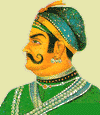 Prithviraj
was the son of Someshwara who died in 1179
A.D. The second Turkish attack was led by Mu'izzu'd-Din Muhammad (also known as
Muhammad Ghuri), who conquered Sindh and Lahore in 1182. Soon after, he
commenced his attack on the Rajput kingdoms. Prithviraj Chauhan successfully led
the Rajputs against Ghuri at the first battle of Tarain in 1191 AD. However, at
the second battle in 1192 AD, Prithviraj who became the last Hindu
ruler was defeated and the kingdom of Delhi fell to Muhammad Ghuri. Prithviraj
was the son of Someshwara who died in 1179
A.D. The second Turkish attack was led by Mu'izzu'd-Din Muhammad (also known as
Muhammad Ghuri), who conquered Sindh and Lahore in 1182. Soon after, he
commenced his attack on the Rajput kingdoms. Prithviraj Chauhan successfully led
the Rajputs against Ghuri at the first battle of Tarain in 1191 AD. However, at
the second battle in 1192 AD, Prithviraj who became the last Hindu
ruler was defeated and the kingdom of Delhi fell to Muhammad Ghuri.
Prithviraj Chauhan, king of Delhi, magnanimously let
Ghuri off. Legend has it - and it is widely believed in India - that when Ghori
eventually succeeded in defeating Prithviraj Chauhan at the Second Battle of
Tarain in 1192, he blinded him and took him in chains to Afghanistan along with
his friend, the poet Chandravardai.
Adhai – din- ka- Jhonpra -
Its construction took two and a half days (Adhai-Din) to complete. It was
originally a Sanskrit college, built within a temple. In 1193 A.D., Mohammad
Ghauri conquered Ajmer and converted the building into a mosque by adding a
seven arched wall in front of the pillared hall in just two-and-a-half days (adhai-din)
and hence the name.
To this day, Prithviraj Chauhan is
remembered by the Rajputs as a model of chivalry and courage, and is the hero of
many folk ballads.
(For more refer to chapter on Islamic
Onslaught). Watch History
of Ayodhya - videogoogle.com.
Top
of Page
Decolonizing
Indian Studies ?
 An address at North Gujarat
University, delivered by Makarand Paranjpe
of the English department at JNU. Astonishingly, here
is an actual real-life JNU person writing about the need for 'Decolonizing
Indian Studies: Attaining Swaraj'. An address at North Gujarat
University, delivered by Makarand Paranjpe
of the English department at JNU. Astonishingly, here
is an actual real-life JNU person writing about the need for 'Decolonizing
Indian Studies: Attaining Swaraj'.
He mentions, approvingly, that Bhartrihari's
Vakyapadiya, Panini's Asthadhyayi,
and Bharata's Natyashastra
have been introduced into the curriculum at JNU. Amazing that such a
thing could ever happen at that last bastion of neo-imperialist Marxist
obscurantism, that white elephant devoted to Fabian Socialist-Stalinist ideas
that have been thrown in the trash everywhere else. Says Paranjpe: "The
point is that the day you begin to take your own tradition seriously, you begin
to get a strength, a grounding, a sense of belonging, a purpose, and an
identity... you experience liberation, decolonization... [And] if you are
serious about critiquing Indian traditions you first have to read them, you
first have to engage with them. This, a lot of us are unable or unwilling to do.
We are used to condemnation and repudiation, often mouthing the very words of
those who tried systematically to destroy this civilization."
(source: http://www.rediff.com/news/2001/may/16rajeev.htm.
Refer to chapters on First
Indologists, European
Imperialism,
Glimpses VIII,
Glimpses IX and
Glimpses X).
For
more refer to chapter on Greater
India: Suvarnabhumi and Sacred
Angkor
Top
of Page
Khakis are from
India
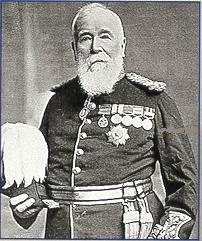 While serving in the heat of India,
Sir Henry Lumsden dyed his pajama bottoms khaki (Hindi for 'dust') so he can
wear comfortable pants and still look presentable. Khaki is a closely twilled
cloth of linen or cotton, dyed a dust color. The color caught on with
troops worldwide. While serving in the heat of India,
Sir Henry Lumsden dyed his pajama bottoms khaki (Hindi for 'dust') so he can
wear comfortable pants and still look presentable. Khaki is a closely twilled
cloth of linen or cotton, dyed a dust color. The color caught on with
troops worldwide.
Today khakis have made it from World War II to civilian
life.
A New Vocabulary
The
British during their time in India incorporated into speech many
Indian terms that, because of their familiarity and usefulness, made
their way to England and beyond. A sampling of 900 words or so
adopted from India include:
bandanna,
bangle, bungalow, calico, cheroot, chintz, chit, chutney, cot,
cummerbund, curry, cushy, dinghy, dungaree, gunny, jodhpurs, khaki,
loot, musk, pajamas, pariah, punch, pundit, sandal, seersucker,
shawl, shampoo, swastika, thug, tomtom, and veranda.
(source: What
Life Was Like in the Jewel of the Crown: British India AD 1600-1905
- By The Editors of
Time-Life Books.
p. 119). For more refer to chapter on European
Imperialism).
Top
of Page
The Puranas
Partition, which the British
wilfully and consciously left behind as a parting gift (remember the words of
Churchill when he learnt of the chaos following Partition: 'At last, we've had
the last word').
It is used to be the general opinion
of Western scholars that the Puranas belonged to the latest productions of
Sanskrit literature and came into existence during the last thousand years.
However, this view is not accepted today. The Poet Bana
knew the Purana very well and he tells us that he attended a reading of the Vayu
Purana in his native village. Kumarila Bhatt relies on the Puranas as a source
of law. Shankara and Ramanuja referred to the Puranas as ancient and sacred
text. Arab Albernuei was familiar with the
Puranas and he gives us a list of the 18 Puranas. There is a lot of common
between the Puranas and Latiavistara. The Puranas are 18 in number but all of
them are not equally important for historical purposes. As a source of history,
we depend largely on the Vishnu Puranas, Vayu Puranas, Matsya Puranas, Brahma
Puranas and Bhavishya Puranas. The Puranas start with the rulers who trace their
origin from the Sun and the Moon. They describe the various kings who ruled in
the Madhyadesh. They give the names of the Puru kings of Hastinapur and the
Ikshvaku King of Kosala. The give us details about Sisunaga Kings and Nanda
Kings.
Dr. V. A.
Smith has shown that the Vishnu Puranas is reliable as regards to the
Mauryan dynasty and the Matsya Purana is reliable as regards to the Andhra and
Saisunaga dynasties. the Vayu Purana describes the rule of the Guptas as it was
under Chandragupta I. At the end of the list of kings certain Puranas give a
series of dynasties of low and barbarian origin such as Abhiras, Gardabhas,
Sakas, Yavanas, Tusaras, Hunas etc...
The Puranas can be used for the
purpose of building up the history of ancient Indian geography. In them, we come
across the names of very many cities which existed in their times. The distances
between cities is mentioned as well as names of rivers and mountains.
There is a tendency among modern
scholars to belittle the value of the information found in the Puranas. It has
been suggested that the genealogies of the Puranas were invented by some fertile
brains. However, there is nothing to support such a view. The Pauranikas profess
to tell the truth and they had nothing to gain from kings and their descendents
who were already dead and gone. Most western scholars
seem to suffer from the old prejudice against the Puranas dating from the time
of Lord Macaulay. It is high time that the scholars give up their prejudices and
give the Puranas a due place as a source of ancient Indian History.
(source: Ancient
India - By V. D. Mahajan p. 19-21). For
more refer to chapter on Greater
India: Suvarnabhumi and Sacred
Angkor
Top
of Page
Education in
Ancient India
Education
in India has always been regarded as one of the basic inputs in human resource
development. In the ancient days, the Gurukul system of education was
prevalent. The teacher was the Guru and the disciple was the Sishya.
The disciples lived in the Guru's aashram during the course of their
training and in turn offered their services to the ashram. This period of
learning of, about 12 years, was considered as a great sacrifice or a penance.
The Guru identified the capability of his Sishya and accordingly imparted
knowledge. The sishyas learnt amidst the natural surroundings of the ashram, in
open air, in close contact with nature. The
Kings sent their Princes to Gurus for training on the art of using weaponry, vedas,
music, art and physical forms of exercising & defence. At the end of their
training, the disciples thanked their Gurus with a gift in the form of a gurudakshina
- which literally means "offerings to the Guru".
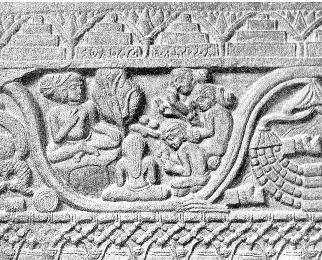 One of the most
popular cultural institutions in India which still follows the Gurukul
system is Shanthiniketan near Calcutta which was established by the great
teacher, artist, philosopher and literary laureate Rabindranath Tagore. Kalakshetra
in Madras, established by the great dancer Rukmini Arundale too follows
the Gurukul system. To-date, a teacher in India is regarded as a Guru, a master
in his discipline. One of the most
popular cultural institutions in India which still follows the Gurukul
system is Shanthiniketan near Calcutta which was established by the great
teacher, artist, philosopher and literary laureate Rabindranath Tagore. Kalakshetra
in Madras, established by the great dancer Rukmini Arundale too follows
the Gurukul system. To-date, a teacher in India is regarded as a Guru, a master
in his discipline.
One
of the most ancient universities of India is in Nalanda near Patna.
Founded in the 5th Century AD, this great seat of learning flourished until the
12th century AD. Gautam Buddha and Parsvanath Mahavir are believed to have
visited Nalanda. The Chinese chronicler Huen Tsang spent many years here both as
a student and as a teacher. Nagarjuna, the Buddhist Mahayana philosopher, Dinnaga, the logician and
Dharmapala, the Brahmin scholar taught
here. At one point of time about 2000 teachers and 10,000 students crowded the
portals of Nalanda University. Besides religious texts, students in the ancient
universities learnt about Ayurveda (Medicine), Ganitha (Mathematics), Arthashastra
(Political science), Jyothisha (Astrology), Vyakarna (Grammar), Shilpathana Vidya
(Art and Crafts), and Adyatma Vidya (Philosophy).
(source: http://www.geocities.com/tokyo/shrine/4287/education.htm
- For more on education, please refer to chapter on Education
in Ancient India).
Christians are also proud that they brought
education to India, "but," counters Sri Sri Ravi
Shankar, Founder of the
Bangalore based Art of Living, an International Foundation. He recently
addressed the UN Peace Summit on Aug 28. He is the only non-westerner to serve
on the advisory board of Yale University's School of Divinity and is author of
the book - Hinduism and Christianity:
"it is not true: there were for instance 125,000 medical
institutions in Madras before the British came. Indians never lacked
education, the Christians only brought British education to India,
which in fact caused more damage to India by westernizing many of
us."
Sri
Aurobindo has commented on the state of education: "In
India...we have been cut off by a mercenary and soulless education from all our
ancient roots of culture and traditions..."
(source: India's Rebirth
- By Sri Aurobindo
Publisher: Mira Aditi ISBN 81-85137-27-7 p 65). (For more refer to chapter on
European
Imperialism).
In the Round- table conference in
1931, Mahatma Gandhi in
one of his speeches said,
"The beautiful tree of education was cut down by you British. Therefore
today India is far more illiterate than it was 100 years ago."
Top
of Page
Gupta period -
The Classical Age in India
According to (Marxists) historian Romila
Thapar, the Gupta Age as the Classical Age of ancient India is true
so far as the upper classes are concerned, amongst whom standards reached a peak
never before attained. Dr. D. N. Jha has
also concluded: " For upper classes, all periods in history have been
golden: for the masses, none. The true golden age of the people does not lie in
the past, but in the future.
In the light of what has been stated
by V. A. Smith, Dr. R. C. Majumdar, Dr. M.A. Mehendale,
and Prof. R.N. Dandekar in the support of the view that the Gupta
period was the Golden Age of Indian history, the criticism of Romila Thapar and
Dr. D.N. Jha does not seem to be convincing. (Both Thapar and Jha are known for
their Marxist interpretation of Indian history). Moreover, Dr. Sriram Goel
points out that main emphasis of the critics is on the point that prosperity and
culture of the Guptas did not reach certain classes and certain areas.
According
to Dr. Goyal, those critics have shown, the mentality of a drain inspector who
concentrates merely on certain shortcomings in a system. They have tried to
misinterpret and distort certain facts. Dr. Goyal points out that the benefits
of progress does not reach all the regions in any country or society. Such a
thing did not happen even in Athens in the Periclean Age. It did not happen in
the Age of Elizabeth.
(source: Ancient
India - By V. D. Mahajan S. Chand and Company Ltd. New Delhi 1990 p. 575-577).
For more refer to chapter on Greater
India: Suvarnabhumi and Sacred
Angkor
Top
of Page
Prayer in US
Schools Doesn't Mean Christian Prayer
A frequent proposal from the Christian Right in America is for a constitutional
amendment to allow voluntary prayer in public schools. Proponents will cite
results from the Gallup poll, such as at "source," which show 78% of
Americans support such an amendment. What they don't usually cite is the
response to this question Gallup also posed: "Suppose spoken prayers were
allowed in the local public schools. Do you believe that the prayers should be
basically Christian, reflecting Christian beliefs and values, or should the
prayers reflect all major religions, including Christianity?" 76% say the
prayers should "reflect all major religions" and only 18% say
basically Christianity. So if the amendment ever does pass -- a very unlikely
scenario -- Hindu and Buddhist prayers would be just as eligible for the
classroom as anything from Christianity.
(source: http://www.hinduism-today.com/#3).
Top
of Page
Vijayanagar - the
splendor
Of all the kingdoms of the south,
Vijayanagar was the finest with the longest history. It was founded in
1336 and was visited by Italian Nicolo Conti
who came in 1420; Abdur-Razzaq of Herat, in
1443; and Paes, a Portuguese, who visited
the city in 1522. Abdur-Razzaq from central Asia wrote of a temple made of pure
molten brass: "It was 15 feet high, and 30 feet high by 30 at its
base." He goes into ecstasies over the city" "The city is such
that eye has not seen nor ear heard of any place resembling it upon the whole
earth."
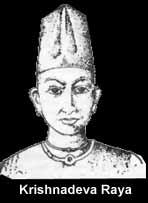 Paes,
who came in 1522, describes it: "The city of
Vijayanagar, is as large as Rome and very beautiful to the sight."
He describes at length the wonders of the city, and the charms of its
innumerable lakes and waterways and fruit gardens. It is the best-provided city
in the world...for the sate of the city is not like that of other cities, which
often fail of supplies and provisions, for in this everything abounds." He
also describes the great ruler of Vijayanagar at the time of his visit. He was
one of the great rulers of South Indian history, and his reputation as a great
warrior, and as one who was chivalrous to his enemies, as a patron of
literature, and a popular and generous king, still survives in the south. His
name was Krishna Deva Raya, and he ruled
from 1509-1529. "Great irrigation works were erected about 1400 to bring
good water to the city. A whole river was dammed up and a big reservoir was
made. From this the water went to the city in an aqueduct, 15 miles in length,
often out of the solid rock. Paes,
who came in 1522, describes it: "The city of
Vijayanagar, is as large as Rome and very beautiful to the sight."
He describes at length the wonders of the city, and the charms of its
innumerable lakes and waterways and fruit gardens. It is the best-provided city
in the world...for the sate of the city is not like that of other cities, which
often fail of supplies and provisions, for in this everything abounds." He
also describes the great ruler of Vijayanagar at the time of his visit. He was
one of the great rulers of South Indian history, and his reputation as a great
warrior, and as one who was chivalrous to his enemies, as a patron of
literature, and a popular and generous king, still survives in the south. His
name was Krishna Deva Raya, and he ruled
from 1509-1529. "Great irrigation works were erected about 1400 to bring
good water to the city. A whole river was dammed up and a big reservoir was
made. From this the water went to the city in an aqueduct, 15 miles in length,
often out of the solid rock.
Other descriptions of Vijayanagar:
" The opulent palaces, the magnificent temples and the massive
fortifications appear very natural among the rock formations, as if they have
just grown out of these theatrical, barren, craggy surroundings. A foreigner
said of the stones: ``they are piled one block on another in a manner most
singular, that it seems as if they stood in the air, not connected with each
other''.
" One of the finest is the
Hazara Rama
temple, an exquisite structure for private worship of the Vijayanagar kings.
Standing within a walled enclosure, it exudes an air of elegant serenity either
when the moonlight softly washes over the friezes, or when it glows in the
sunlight. The herds and bands of elephants, horses, dancing girls and musicians,
and scenes from the Ramayana come alive on the outer walls of the temple. The
eye lingers on the fine features of a musician, or the graceful limbs of a
dancing girl or the noble prancing of a caparisoned steed. Inside, the four
black polished pillars invite you to run your fingers over their smoothness.
Their geometrical square blocks alternate with cylindrical shafts, all
luxuriantly carved in tangible loveliness."
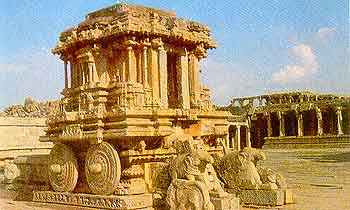 "The
large stone chariot in the Vithala
temple is a marvelous testimony to the skill of the stone carvers - its wheels
can rotate on the axle.
The carved pillars in the Hall
of Musical Pillars
resound like musical instruments. The Hampi ruins include the monolithic statues
of Ugra Narasimha (Vishnu's incarnation of the man-lion creature), badly
mutilated by the invading Moghul armies and Ganesa. The 22 ft. high statue of
Narasimha had Lakshmi seated on his thigh - unfortunately it was hacked to
pieces. The Virupaksha
temple has beautiful
gopurams, and on the way there is the King's Balance on which he was weighed
against gold and diamonds which were then distributed to the people." "The
large stone chariot in the Vithala
temple is a marvelous testimony to the skill of the stone carvers - its wheels
can rotate on the axle.
The carved pillars in the Hall
of Musical Pillars
resound like musical instruments. The Hampi ruins include the monolithic statues
of Ugra Narasimha (Vishnu's incarnation of the man-lion creature), badly
mutilated by the invading Moghul armies and Ganesa. The 22 ft. high statue of
Narasimha had Lakshmi seated on his thigh - unfortunately it was hacked to
pieces. The Virupaksha
temple has beautiful
gopurams, and on the way there is the King's Balance on which he was weighed
against gold and diamonds which were then distributed to the people."
In a series of wars Rama Raja completely defeated the Bijapur ruler to inflict
humiliating defeats on Golconda and Ahmadnagar. It seems Rama Raja had no larger
purpose than to maintain a balance of power favourable to Vijayanagara. The five
broken Bahamani kingdoms, did a combined crusade on Vijayanagara at Bannihatti
in 1565 and in the battle of Rakshasa-Tangadi, Rama Raja was surrounded, taken
prisoner and immediately executed and this brought an end to the Best Empire of
the South. It was
thoroughly looted and left in ruins.
(source: Glimpses
of World History - By Jawaharlal Nehru p.
257-259 and The stones of Hampi
- By Maya Jayapal). For more information on architecture refer to
chapter Hindu Art).
For
more refer to chapter on Greater
India: Suvarnabhumi and Sacred
Angkor
Top
of Page
Is India
Civilized?
Is
India Civilized: Essays on Indian Culture a book under this
rather startling title was published some decades ago, by Sir
John Woodroffe, the well known scholar and writer on Tantric
philosophy. That well known dramatic critic, Mr.
William Archer, leaving his safe natural sphere for
fields in which his chief claim to speak was a sublime
and confident ignorance, assailed the whole life and culture of India and even
lumped together all her greatest achievements, philosophy, religion, poetry,
painting, sculpture, Upanishads, Mahabharata, Ramayana, in one wholesale
condemnation as a repulsive mass of unspeakable barbarism.
It
is argued by many at the time that to reply to a critic of this kind was to
break a butterfly, or it might be in this instance a bumble-bee, upon the wheel.
What he has done is to collect together in his mind all the unfavorable comments
he has read about India, eke them out with casual impressions of his own and
advance this unwholesome and unsubstantial compound as his original production,
although his one genuine and native contribution is the cherry cocksureness of
his second-hand-opinions. The book is a journalistic fake, not an honest
critical production.
Both materially and spiritually
Europe has thrown herself repeatedly upon Asia, to conquer, assimilate and
dominate. India, is the quintessence of the Asiatic way of being.
(source: The
Foundations of Indian Culture - By Aurobindo p. 1-45).
Top
of Page
For Europeans
Only
In his Discovery
of India (written in 1943), Jawaharlal
Nehru recorded how humiliating he had found it always to
see posted in railway carriages, in station waiting rooms, on park
benches, and in other places the exasperating sign "For
Europeans Only." He added:
"The idea of a
master race is inherent in imperialism. There was no subterfuge
about it; it was proclaimed in unambiguous language by those in
authority. More powerful than words was the practice that
accompanied them, and generation after generation, and year after
year, India as a nation and Indians as individuals were subjected to
insult, humiliation, and contemptuous treatment....The memory of it
hurts, and what hurts still more is the fact that we submitted for
so long to this degradation."
Nehru
has remarked:
"In India every European, be he German, or Pole or Rumanian, is
automatically a member of the ruling race. Railway carriages, station retiring
rooms, benches in parks, etc. are marked 'For Europeans Only.' This is bad
enough in South Africa or elsewhere, but to have to put up with it in one's own
country is a humiliating and exasperating reminder of one's enslaved
condition."
(source: The
Discovery of India - By Jawaharlal Nehru p.295). (For more
refer to chapter on European
Imperialism).
Top
of Page
Great
Zimbabwe (Africa) and Eurocentrism
If
it was great, it must have been white: If advanced
science, art, or architecture is found in Africa or South America,
then Phoenecians, Greeks, Celts, Vikings must be invoked to explain
their presence.
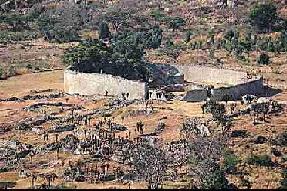 Alluding
to the way in which the spectacular stone ruins of Great Zimbabawe (zimbabwe means
"stone enclosure") were viewed as Phoenician creation, M.
Posnansky (1982) refers to "the notion that what was advanced in
Africa's past was the work of outside invaders, merchants or metal-workers,
variously derived from Phoenicia, Israel, India and Indonesia." He adds
that Alluding
to the way in which the spectacular stone ruins of Great Zimbabawe (zimbabwe means
"stone enclosure") were viewed as Phoenician creation, M.
Posnansky (1982) refers to "the notion that what was advanced in
Africa's past was the work of outside invaders, merchants or metal-workers,
variously derived from Phoenicia, Israel, India and Indonesia." He adds
that
"this was an
idea that was extremely attractive to the White community that at no time
amounted to even 10 per cent of the total population of Rhodesia. It served to
justify their depreciation of the Black capabilities and past achievements and
their occupation of more than half of the best agricultural land. The
preservation of White civilization ultimately retarded the discovery of Black
civilization and hampered the progress of archaeology."
About the 11th century
AD the first stone building began, and this rapidly developed into a
distinctive and impressive architectural style. Stone building
reached its first peak in the city of Great Zimbabwe, which was
built between the 11th and 15th centuries. Several attempts by
people to argue for an early external origin for Great Zimbabwe.
Archaeologists and historians believe that from the 13th to 15th
centuries Great Zimbabwe was the capital for a large area in
southern Africa. Throughout this region there are smaller but
similar madzimbabwe. The site Great Zimbabwe covers over 1779 acres
and comprises mainly stone wall enclosures and areas of hut remains.
Because of the wealth of Zimbabwe and the importance of Sofala as a
trading city, the Zimbabweans from 1000 AD onwards were exposed to Indian,
Chinese, and Persian crafts and culture.
(source: Colonial
Indology: Sociopolitics of the Ancient Indian Past - By Dilip K. Chakrabarti
p. 25-26). (For more refer to chapter on European
Imperialism). For
more refer to chapter on Greater
India: Suvarnabhumi and Sacred
Angkor
Top
of Page
France's love affair with Shiva
continues
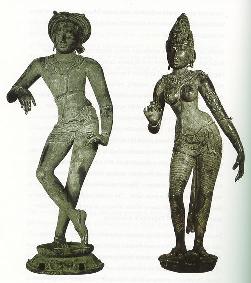 Shiva, the
Hindu god of destruction, continues to fascinate the French literary
world that has already seen the publication of numerous books on
him. Two more books on differing aspects of Shiva have joined the
list. "Le religion de Shiva" (The religion of Shiva) has
been written by renowned Sanskrit scholar, N. Ramachandra Bhatt.
Bhatt, who has exceptional understanding of the Sanskrit texts, has
explored in depth ancient texts and through it studied history in a
scientific line," says the preface of the book. Shiva, the
Hindu god of destruction, continues to fascinate the French literary
world that has already seen the publication of numerous books on
him. Two more books on differing aspects of Shiva have joined the
list. "Le religion de Shiva" (The religion of Shiva) has
been written by renowned Sanskrit scholar, N. Ramachandra Bhatt.
Bhatt, who has exceptional understanding of the Sanskrit texts, has
explored in depth ancient texts and through it studied history in a
scientific line," says the preface of the book.
The second book,
written by Catherine Clement, a renowned French writer and wife of a
former French diplomat who had served in India, deals with Varanasi,
a city closely related to Shiva. "Le religion de Shiva,"
translated into French by French Sanskrit
scholar Pierre-Sylvain Filliozat and published by
Editions Agamat, tries to explain Hinduism through the famed temple
art of South India in the medieval ages. Bernard Bouanchaud, owner
of Editions Agamat, an Indophile, says he fell in love with India
during his first visit to the country over 30 years ago and since
then he has been in regular contact with India and its philosophy,
spirituality and religion.
(source: http://www.indiaabroadonline.com/thearts/apr2001/france.shtml).
Top
of Page
Languages -
survival of the fittest?
Sanskrit — never a mass language
— is being used by fewer and fewer people. For centuries, it has turned into
an ossified artefact used only by Hindu priests on duty or finance ministers
showcasing their aesthetic prowess. By trying to impose Sanskrit on school and
college syllabi, the government has made noises about resuscitating a dead
language. While the immediate parallel to Sanskrit is Latin — used on
occasions to show erudition — one must not forget the Israeli experiment of
resurrecting Hebrew. While the task of making a new nation speak a forgotten
tongue had more to do with the construction of a national identity rather than
linguistic preservation, Hebrew today is alive and kicking.
Taj Mahal: A
stable?
R P Anand, professor of international law at JNU,
writes:
"In the 19th century, the Britishers had turned the Taj into a
stable. It also wanted to take it apart to sell the marble..."
(source: Why
is the world helpless?
http://www.timesofindia.com/040301/04sprp3.htm).
For more information go to TAJ MAHAL AND THE GREAT BRITISH CONSPIRACY http://www.hindunet.org/hindu_history/modern/godbole_taj2.html
)
Top
of Page
Diamonds of India
Hope
Diamond
 The
"Great Blue Diamond", the Hope is also called the "cursed
diamond" because it is said to have brought nothing to its possessors but
tragedy. Nothing is further from the truth. A jewel trader,
Jean-Baptiste Tavernier, purchased it in India and sold it in 1669 to
Louis XIV, who had it cut into the heart shape, which reduced its weight from
112 to 68.8 carats. Later, the stone was stolen, and it came into the possession
of the British banker Philip Pierre Hope in 1830. Via Sultan Abdul-Hamid, the
Paris jeweler Pierre Cartier, and the newspaper magnate William McLean, the Hope
diamond landed in the United States. In 1958, a diamond dealer Harry Winston
donated it to the Smithsonian Institute where it is now on display. The stone
was sent to the Institute by ordinary mail. The
"Great Blue Diamond", the Hope is also called the "cursed
diamond" because it is said to have brought nothing to its possessors but
tragedy. Nothing is further from the truth. A jewel trader,
Jean-Baptiste Tavernier, purchased it in India and sold it in 1669 to
Louis XIV, who had it cut into the heart shape, which reduced its weight from
112 to 68.8 carats. Later, the stone was stolen, and it came into the possession
of the British banker Philip Pierre Hope in 1830. Via Sultan Abdul-Hamid, the
Paris jeweler Pierre Cartier, and the newspaper magnate William McLean, the Hope
diamond landed in the United States. In 1958, a diamond dealer Harry Winston
donated it to the Smithsonian Institute where it is now on display. The stone
was sent to the Institute by ordinary mail.
The Daryinoor
 The
Crown Jewels of Iran are considered to be the finest in the world-exceeding even
those of the United Kingdom and Austria-Hungary. Along with the Noor-al-Ain,
Precious Light, the Darya-I-Noor once formed the world's largest pink diamond,
the Great Table. A centerpiece of the Crown Jewels of India, the Darya-I-Noor
was brought to Iran by the great conqueror Nadir Shah where it became the most
spectacular gem in the considerably imposing collection. Considered the sister
of the Kohinoor, Mountain of Light, the Darya-I-Noor was reunited with its real
sibling in 1959 when the Shah purchased the Precious Light diamond for a wedding
tiara. Because of its legendary origins, its rank as one of the world's largest
diamonds.. The
Crown Jewels of Iran are considered to be the finest in the world-exceeding even
those of the United Kingdom and Austria-Hungary. Along with the Noor-al-Ain,
Precious Light, the Darya-I-Noor once formed the world's largest pink diamond,
the Great Table. A centerpiece of the Crown Jewels of India, the Darya-I-Noor
was brought to Iran by the great conqueror Nadir Shah where it became the most
spectacular gem in the considerably imposing collection. Considered the sister
of the Kohinoor, Mountain of Light, the Darya-I-Noor was reunited with its real
sibling in 1959 when the Shah purchased the Precious Light diamond for a wedding
tiara. Because of its legendary origins, its rank as one of the world's largest
diamonds..
The Orlov
 The
Orlov diamond, originally called the Sun of the Sea, once
decorated a Hindu temple statue. A French deserter stole it and sold
it in Madras to a British sea captain, who in turn, sold it to a Jew who passed
it on to a Persian. This man met Count Grigory Grigoryevich Orlov, a rejected
lover of Catherine II the Great, who bought the Sun of the Sea for 400,000
rubles, a fabulous sum at the time. Although the Empress accepted the gift, her
love was not reawakened. The Count died in an institution for the mentally ill.
It may be a comfort to him that the diamond now bears his name. It is now in the
Kremlin, mounted on the imperial scepter. The
Orlov diamond, originally called the Sun of the Sea, once
decorated a Hindu temple statue. A French deserter stole it and sold
it in Madras to a British sea captain, who in turn, sold it to a Jew who passed
it on to a Persian. This man met Count Grigory Grigoryevich Orlov, a rejected
lover of Catherine II the Great, who bought the Sun of the Sea for 400,000
rubles, a fabulous sum at the time. Although the Empress accepted the gift, her
love was not reawakened. The Count died in an institution for the mentally ill.
It may be a comfort to him that the diamond now bears his name. It is now in the
Kremlin, mounted on the imperial scepter.
The Shah of Persia
 Nadir
Shah of Delhi, India, owned this 99.52-carat, yellow, cushion shaped diamond
in1739. It was believed that the diamond was presented to General V.D.
Starosselky, a Russian military expert for his excellent command of the Persian
army. The general brought the diamond to America. The diamond is mounted in a
pendent brooch with 72 smaller diamonds. For a long time, this pendent was owned
by Carl D. Lindstrom, a Los Angeles gems dealer. Harry Winston, a New York City
gem dealer bought it in 1957. Nadir
Shah of Delhi, India, owned this 99.52-carat, yellow, cushion shaped diamond
in1739. It was believed that the diamond was presented to General V.D.
Starosselky, a Russian military expert for his excellent command of the Persian
army. The general brought the diamond to America. The diamond is mounted in a
pendent brooch with 72 smaller diamonds. For a long time, this pendent was owned
by Carl D. Lindstrom, a Los Angeles gems dealer. Harry Winston, a New York City
gem dealer bought it in 1957.
The Pigott
Supposedly, this diamond weighed form 47 to 85.80 carat, it is a fine
quality Indian diamond. Named after Baron George Pigott who acquired
it in 1775 from an Indian Prince, this diamond changed hands several
times, ending finally in the hands of Ali Pashas, ruler of Albania in 1818 for
$150,000.
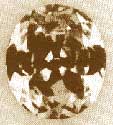 He carried it around in a small bag and seldom showed it to anyone. The
Sultan of Turkey, over lord of Albania, became envious of Ali's popularity and
sent his army to capture Ali. During the fighting, the 80-year-old Ali was
fatally wounded, he ordered his captain to his side, gave him the diamond and
asked him to smash it right there and then. He carried it around in a small bag and seldom showed it to anyone. The
Sultan of Turkey, over lord of Albania, became envious of Ali's popularity and
sent his army to capture Ali. During the fighting, the 80-year-old Ali was
fatally wounded, he ordered his captain to his side, gave him the diamond and
asked him to smash it right there and then.
The
Great Mogul
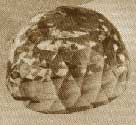 When found the Great Mogul Diamond weighed 787.50 carat in the
rough. After it was cut into a rose cut diamond it weighed only 280 carats. The
owner of the stone, Emperor Shah Jahan, who is also the builder of the Taj Mahal
fired and fined the cutter $10,000 (the cutter's entire fortune) for doing such
a poor job. The whereabouts of this diamond is unknown. When found the Great Mogul Diamond weighed 787.50 carat in the
rough. After it was cut into a rose cut diamond it weighed only 280 carats. The
owner of the stone, Emperor Shah Jahan, who is also the builder of the Taj Mahal
fired and fined the cutter $10,000 (the cutter's entire fortune) for doing such
a poor job. The whereabouts of this diamond is unknown.
(source: Diamonds
of India
- Hindustan Times).
The Star of
Africa
The
biggest chunk, the Star of Africa, is 530 carats, has 74 facets, and is
considered the largest cut diamond in the world. It is also part of the British
crown jewels.
The
Cartier Necklace
There
is also the Cartier necklace, which was recently on display in New York.
Commissioned by the Maharaja of Patiala in 1928, it was laid with 2,930 diamonds
and weighed almost a thousand carats.
The Sancy
Diamond
 Sancy
Diamond, a 55-carat pale yellow stone that fluoresces yellow and
pink. It was found in India, passed through French and English kings, was bought
by a Bombay merchant in the 19th century but lost to America's Lady Astor (who
set it on her wedding tiara) before it was retrieved by the French. Current
resting place: The
Louvre. Sancy
Diamond, a 55-carat pale yellow stone that fluoresces yellow and
pink. It was found in India, passed through French and English kings, was bought
by a Bombay merchant in the 19th century but lost to America's Lady Astor (who
set it on her wedding tiara) before it was retrieved by the French. Current
resting place: The
Louvre.
The
Regent Diamond
The
Regent, which weighed more than 410 carats when discovered by a slave near
Golconda in the 18th century.
The
bauble was once owned by William Pitt, the English prime minister, who sold it
to the Duke of Orleans, the regent of France (hence, The Regent). Louis
XV wore it at his coronation and it adorned the hat of Marie Antoinette.
After
the French Revolution, it was owned by Napoleon Bonaparte who set it in the hilt
of his sword. It is now on display in the Louvre.
India has lost the great Kohinoor Diamond, marble bath of Shah Jahan and the
Amravati marbles.
(source:
Lost
baubles from India -
timesofindia.com).
(For more refer to chapters on European
Imperialism and Glimpses
VIII).
Top
of Page
Persecution
Forcing Hindus to Flee Pakistan
Religious persecution and violation of human rights are forcing Hindus in
Pakistan to flee to India, a Pakistani migrants association said today. Each
month groups of persecuted Hindus are coming to India in the hope of a better
future, but they face a tough time due to the lack of a refugee policy in the
country, the Visthapit Sangh said. There are 17,000 Hindu refugees who have yet
to get Indian citizenship. Five thousand of them live in Jodhpur alone. Many of
those who arrived in India as refugees in 1965 have also not received
citizenship, convenor of the Sangh, Hindu Singh Sodha, told reporters. Others
are scattered in Barmer, Jaisalmer, Jalore and Pali districts. He said the
Centre should amend the Citizenship Act and fix a time limit for granting
citizenships. He also said the government should review the rehabilitation
policy prepared in 1978 for those living in camps after leaving Pakistan in 1965
and 1971.
(source: http://www.rediff.com/news/2001/sep/05pak3.htm).
Top
of Page
 Did You Know? Did You Know?
Kaliyug - The Age of Kali
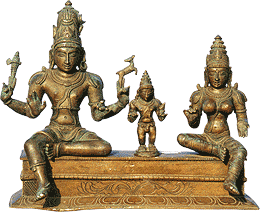 According to Vedic scriptures, we are now living
in the kaliyuga, the age of Kali. We are given to using the term kaliyuga quite
freely and frequently, not quite knowing its import or significance. In the
cosmic timetable, kaliyuga is the last of the four yugas (ages) - satyayuga,
tretayuga, dwaparyuga and kaliyuga - called chaturyuga. The duration of kaliyuga
is said to be 432,000 years; of dvaparayuga 864,000 years; of tretayuga
1,296,000 and of satyayuga 17,280,000 years. Kaliyuga
is so called because it is dominated by Kali, the embodiment of evil. According to Vedic scriptures, we are now living
in the kaliyuga, the age of Kali. We are given to using the term kaliyuga quite
freely and frequently, not quite knowing its import or significance. In the
cosmic timetable, kaliyuga is the last of the four yugas (ages) - satyayuga,
tretayuga, dwaparyuga and kaliyuga - called chaturyuga. The duration of kaliyuga
is said to be 432,000 years; of dvaparayuga 864,000 years; of tretayuga
1,296,000 and of satyayuga 17,280,000 years. Kaliyuga
is so called because it is dominated by Kali, the embodiment of evil.
The abysmal low that human values would descend
to in kaliyuga is vividly described in the twelfth canto of the Srimad
Bhagavatam. The purana forecasts that in kaliyuga people will succumb to the
rule of barbarians who will be steeped in adharma and untruth, and the yuga will
be calamitous for the whole of mankind. All good human qualities and values will
decay; might will be right; wealth will signify goodness; business will
tantamount to cheating and fraud; people will live to eat and not eat to live;
they will observe false dharma; rulers will be unrelenting thieves; humans will
behave like animals; leaders will perpetuate rule by their children; adultery
will be rampant; adharmic persons will preach dharma; people will fight over
trivialities; old and infirm parents will be abandoned as will old and dry cows;
atheism will be widespread and people will mock those who utter the name of
God.
In
the Kalisantarana Upanishad it is stated, "To save oneself from the
contamination of Kali there is no alternative but the chanting of the names of
the Lord".It is said that spiritually inclined people in other yugas who
seek liberation, pray to be born in kaliyuga to take advantage of this bright
silver lining. Even though it is simple and easy, not many are able to follow
this method because of the damning influence of Kali. The story goes that when
Kali was once confronted by a sage and told that his days were numbered because
people would be able to escape his scheming ways simply by remembering the Lord,
shrewd Kali replied, "That is if I let them!".
(source:
Kaliyuga
has a Silver Lining - Parmarthi Raina).
For
more refer to chapter on Greater
India: Suvarnabhumi and Sacred
Angkor
Top
of Page
|